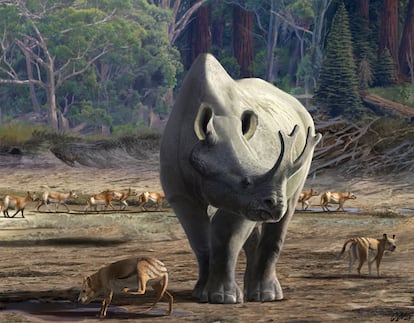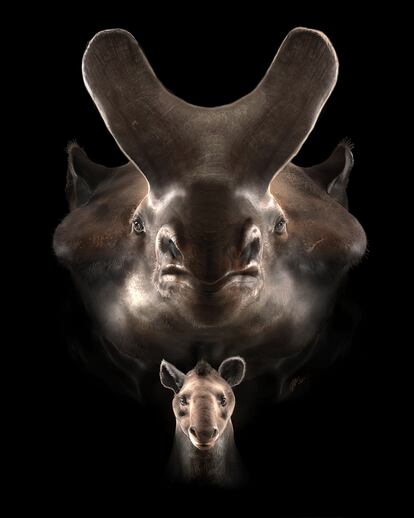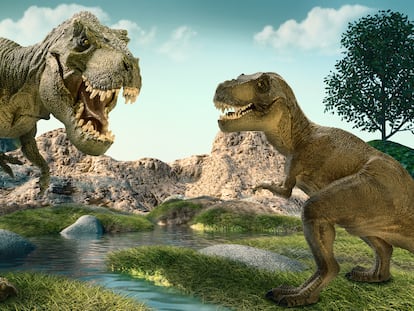Evolution on a grand scale: how, 50 million years ago, the ‘thunder beast’ went from weighing 20 kilos to five tons
A new study explains why some animals became giants after the extinction of the dinosaurs, despite the survivors being much smaller

Extinct animals fascinate us. Gigantic extinct animals, in particular, are awe-inspiring. There are fossils of small animals that are magical, beautiful, perfectly preserved, and fundamental to our understanding of the evolution of life on Earth. But when you’re six years old and you see a diplodocus skeleton for the first time, part of your world is turned upside down. Even though you don’t quite understand how, you suddenly become very aware that such a gigantic creature existed. The unimaginable becomes real because, if you reach out your hand, you can touch its bones.
Gigantic extinct animals, such as mammoths and huge dinosaurs, immediately transport our imagination to almost fantastical prehistoric worlds. The fascination with these primeval beasts is universal and captivates both the uninitiated and specialists alike. It is not surprising, therefore, that many paleontologists have attempted to understand how some animal groups evolved to become so large.
The topic is complex because there have not always been giant animals. Consider the ecosystems just after the late Cretaceous extinction event, 66 million years ago, when an asteroid wiped out non-avian dinosaurs. The largest land animals that survived that event rarely weighed more than 10 kilograms. Some 15 million years later, though, several-tonne mammals were wandering around. How did this happen?
Paleontologists have been grappling with this question for nearly two hundred years, without yet reaching a clear conclusion. So a few years ago, we set out to see if we could find an answer. For our study, whose results are published today in the journal Science, we focused on brontotheres, distant relatives of tapirs and rhinoceroses, which lived on the planet during the Eocene Epoch, between 56 and 34 million years ago. The name brontothere means ‘thunder beast’ and some of the most iconic species had impressive flat and bifurcated horns on their noses.
The earliest brontothere species weighed around twenty kilograms, while the last remaining ones weighed as much as five tons (similar to a modern elephant). For this reason, they are very interesting for learning about the evolution of body size in mammals. Using mathematical models that simulate evolutionary processes and the most precise available data, we compared the different theories that have been developed over the past two centuries to explain the evolution of these titans. This has been a journey through the history of evolutionary theory, the different perceptions we have had about the nature around us, and ultimately, the origin of biodiversity.
Some naturalists from the late nineteenth century, known as neo-Lamarckians, believed that animal lineages were predestined to change towards increasingly specialized forms in their ecologies, larger, and generally more bizarre (for example, developing various types of horns and unusual cranial protrusions). This trend did not reflect an adaptation to the environment, as they ignored Darwin and his adaptationist ideas, which had already been published. Rather, they believed that lineages had their evolutionary histories pre-programmed from the beginning, like in a kind of assembly manual. Their ideas were influenced by Jean-Baptiste Lamarck, a French naturalist who believed that evolution followed an inevitable ladder towards complexity. Neo-Lamarckians believed, for example, that different lineages of mammals (brontotheres, horses, elephants, etc.) were destined to repeat a similar evolutionary path. Only then could they explain those clear trends they repeatedly saw in the fossil record. The mechanisms proposed by Darwin (the survival of the fittest) were too chaotic to explain such linear evolutionary paths: from small and unspecialized to large and specialized.
Darwin couldn’t explain gigantism
At the beginning of the 20th century, and largely thanks to the development of genetics, Darwinist ideas eventually prevailed. But the fossils, stubbornly, showed that many groups of animals actually began small and increased in size over time. To fit these into Darwinist postulates, the old neo-Lamarckian ideas had to be recycled and explained in new terms: being larger must be more advantageous, and larger individuals more ‘fit’, meaning natural selection, operating meticulously over millions of years, will end up producing clear trends towards increasingly larger sizes. As this was a rehash of the ideas of Edward D. Cope, one of the most influential neo-Lamarckian paleontologists, this evolutionary law became known as Cope’s rule.
To buy into this idea, one has to accept that being larger is indeed always more advantageous, across very different groups and over millions of years. Only in a very predictable world could one conceive that the action of natural selection, which operates at the level of the organism (this one is fit and will leave more offspring; this other one, however, will not continue with us), could be extrapolated to evolutionary trends that remain unchanged over tens of millions of years. However, the innumerable climatic and ecological conditions that have occurred over such long periods are rarely so stable and homogeneous.

In fact, the neo-Lamarckian idea of predictability in evolution (and therefore the notion of extrapolation) began to be finally discarded from the 1970s onwards, when a series of new theories were developed that helped make Darwinian precepts more compatible with fossil record data. Natural selection remains the main evolutionary driver, but with some refinements. In the case of Cope’s rule (a general trend towards larger sizes), it could be explained as follows: natural selection operates in response to immediate conditions, here and now.
Therefore, the change in size within animal populations will occur in response to very specific circumstances. When a new species appears, it may be larger or smaller than its ancestor depending on those conditions. This step seems easy enough to accept, but we have just eliminated the ability to extrapolate. Being large no longer always relates to being more fit, but depends on contiguous circumstances. And if descendant species can be larger or smaller, we will never see a clear trend towards increasing size no matter how many millions of years pass. If natural selection does not signal the direction to follow, how do we explain the trends we sometimes see in the fossil record, for example, towards larger sizes?
In the 1970s, theories were developed that made Darwinian precepts compatible with the fossil record. Natural selection remains the main evolutionary driver, albeit with refinements
To better understand this quandary, let’s assume that instead of an evolutionary tree, we have a bonsai and we want it to grow in only one direction (towards larger sizes). We have two options. The first is to gradually force all of its branches to go in that direction, using, for example, guides and wires. This option would reflect Cope’s rule proposed by neo-Lamarckians, since all the branches will tend to go in the preferred direction (towards a larger size). The new branches emerge ever more oriented towards the desired direction than the branch that came before. That is, descendants are always larger than ancestors. Paleontologists of the 1970s, however, proposed a second option: the bonsai tree branches are free to grow in all directions. New branches can appear more to the right or more to the left than the one they derive from. How then do we get the bonsai to grow in only one direction? By using pruning shears to trim the branches on just one side, allowing only those in the desired direction to proliferate.
In the context of evolution, these pruning shears represent an extinction that will mainly affect smaller lineages, leaving only larger lineages to multiply. The trend is not driven by gradual, one-way changes resulting from natural selection of organisms, but rather by a process that selects and prunes entire branches. Branching and pruning are two different processes. Both generate change, but on different scales, with pruning being much more effective. This new perspective paints a much less predictable world, as pruning represents extinction caused by unpredictable factors: environmental changes, cataclysmic events, competition with new groups of animals, etc. Within this perspective, it is difficult to predict what shape the bonsai tree will take because we do not know in advance where the pruning shears will cut. In summary, our theories of evolution have shifted from those that proposed a pre-established evolutionary order (which partly resembles the idea of a divine plan, as defended by natural theology) to more unpredictable, chaotic notions where chance takes more and more control.
Brontotheres and evolutionary pruning shears
Now, let’s return to the brontotheres. Which of these theories fits best with the evolution of these Eocene titans? Our analyses, published in Science, rule out the idea that brontothere lineages always increased in size, as Cope’s rule predicts. Instead, they suggest that the bonsai model with pruning shears better fits the data, meaning new species were not systematically larger than their ancestors. But once new species became established, those that were smaller had a higher risk of extinction. Why? Because the ecological communities of herbivores in that era were littered with species of small and medium sizes, so typical ecological niches of moderate sizes were more saturated, and smaller brontotheres had more competitors.
In other words, our pruning shears were more active on smaller brontothere branches. When larger species appeared, they escaped this competition, survived longer, and could produce other species. This way, larger brontothere species became increasingly more abundant than smaller ones, producing the pattern we observe in the fossil record.
Since these pruning shears represent hard-to-predict factors, what this type of discovery teaches us is that brontotheres were not destined to increase in size. Contingency and chance projected their evolution towards gigantic sizes. If we could rewind evolution back to 66 million years ago and press play again, brontotheres would most likely not follow the same path. Our discovery portrays a less predictable and, therefore, unrepeatable evolution.
Oscar Sanisidro Morant is a paleontologist at the University of Alcalá and scientific illustrator. He is the lead author of the cited study.
Juan López Cantalapiedra is a paleontologist and researcher at the University of Alcalá.
Sign up for our weekly newsletter to get more English-language news coverage from EL PAÍS USA Edition
Tu suscripción se está usando en otro dispositivo
¿Quieres añadir otro usuario a tu suscripción?
Si continúas leyendo en este dispositivo, no se podrá leer en el otro.
FlechaTu suscripción se está usando en otro dispositivo y solo puedes acceder a EL PAÍS desde un dispositivo a la vez.
Si quieres compartir tu cuenta, cambia tu suscripción a la modalidad Premium, así podrás añadir otro usuario. Cada uno accederá con su propia cuenta de email, lo que os permitirá personalizar vuestra experiencia en EL PAÍS.
¿Tienes una suscripción de empresa? Accede aquí para contratar más cuentas.
En el caso de no saber quién está usando tu cuenta, te recomendamos cambiar tu contraseña aquí.
Si decides continuar compartiendo tu cuenta, este mensaje se mostrará en tu dispositivo y en el de la otra persona que está usando tu cuenta de forma indefinida, afectando a tu experiencia de lectura. Puedes consultar aquí los términos y condiciones de la suscripción digital.
More information
Archived In
Últimas noticias
Most viewed
- Reinhard Genzel, Nobel laureate in physics: ‘One-minute videos will never give you the truth’
- Oona Chaplin: ‘I told James Cameron that I was living in a treehouse and starting a permaculture project with a friend’
- Pablo Escobar’s hippos: A serious environmental problem, 40 years on
- Charles Dubouloz, mountaineering star, retires at 36 with a farewell tour inspired by Walter Bonatti
- Why we lost the habit of sleeping in two segments and how that changed our sense of time










































